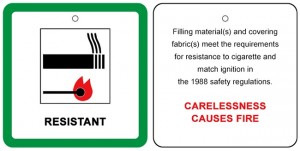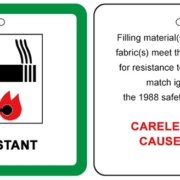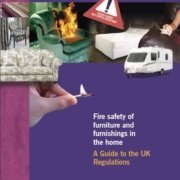Fire safety of furniture and furnishings in your holiday home
Last Updated on August 26, 2015 by admin
 The consequences of a fire in your holiday home can be catastrophic and in some cases fatal; in the last year there were 322 fire related deaths across Great Britain, and whilst this figure is significantly down on the 1988 high of 731, there are on average 39,600 reported dwelling fires every 12 months.
The consequences of a fire in your holiday home can be catastrophic and in some cases fatal; in the last year there were 322 fire related deaths across Great Britain, and whilst this figure is significantly down on the 1988 high of 731, there are on average 39,600 reported dwelling fires every 12 months.
Despite 88% of fires being accidental, it is vital that you remain vigilant in reducing any potential risks in your holiday home in order to ensure your guests can enjoy their stay in the safest possible environment.
What legislation applies to the Fire safety of furniture and furnishings in your holiday home?
One of the biggest alterations made to the fire safety of furniture and furnishings regulations in recent times was the introduction of The Furniture and Furnishings (Fire) (Safety) Regulations 1988 (amended 1989, 1993 and 2010), which looked to ensure that upholstery components and composites used for furniture supplied in the UK meet specified ignition resistance levels.
These regulations, which do extend to holiday homes, highlighted the fact that prior to their introduction, highly flammable furniture was often becoming an accelerant in the spread of fire throughout a home, and posed a significant risk to those inside.
What do you need to be aware of?
Although the majority of regulations are geared toward suppliers and manufacturers, you do need too be aware of your own responsibilities as a holiday homeowner.
Amendments made to the Regulations in 1993 mean that they now apply to the actual ‘supplier of furniture acting in the course of a business’. With a holiday home this will be the owner of the furnished holiday letting property.
When did you buy your furniture?
Furniture purchased since March 1990 should satisfy the Regulations and be permanently labelled. However, if your furniture was purchased prior to this date it will not necessarily satisfy all of the regulatory requirements.
Any furniture manufactured prior to 1950 is outside the scope of the Regulations.
The six core areas of the regulations are:
- Filling materials must meet specified ignition requirements
- Upholstery composites must be cigarette resistant
- Covers must be match resistant (with certain exceptions as outlined in Section 8.2 and Appendix A5)
- A permanent label must be fitted to every item of new furniture (with the exception of mattresses and bed-bases)
- A display label must be fitted to every item of new furniture at the point of sale (with the exception of mattresses, bed-bases, pillows, scatter cushions, seat pads, loose covers sold separately from the furniture and stretch covers)
- The first supplier of domestic upholstered furniture in the UK must maintain records for five years to prove compliance.
For a full guide on the The Furniture and Furnishings (Fire) (Safety) Regulations 1988 please visit this link:
You may also find the following posts for holiday home owners of interest:
- Fire Safety Law For Holiday Letting
- Fire Safety for guests with hearing loss
- Holiday home gas safety checks
- Solid fuel fire safety for holiday home owners
- Protect yourself and your guests from carbon monoxide poisoning
- Preventing the five most common causes of fire holiday homes
Boshers offer specialist holiday home insurance to owners across the UK. For more information on how a specialist insurer can help and support your holiday home business, please give us a call on 01237 429444.







Leave a Reply
Want to join the discussion?Feel free to contribute!